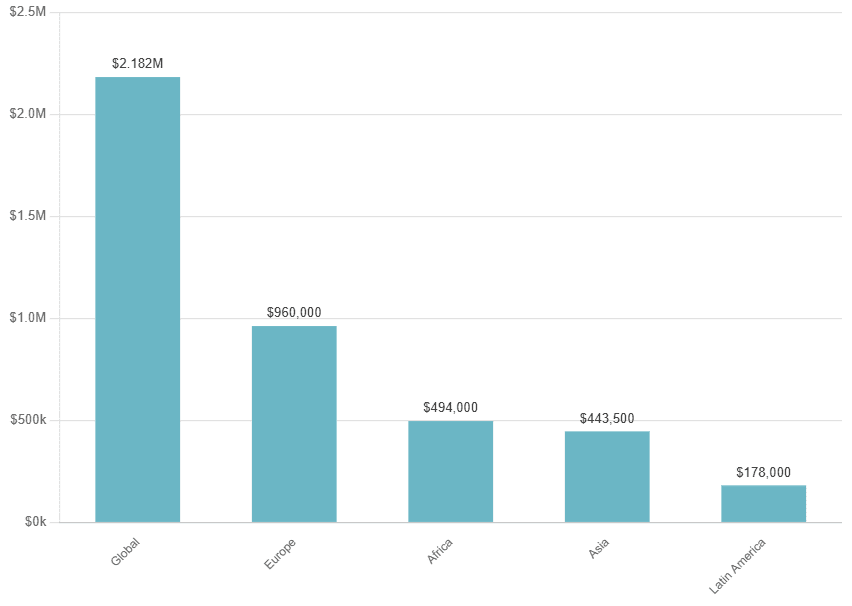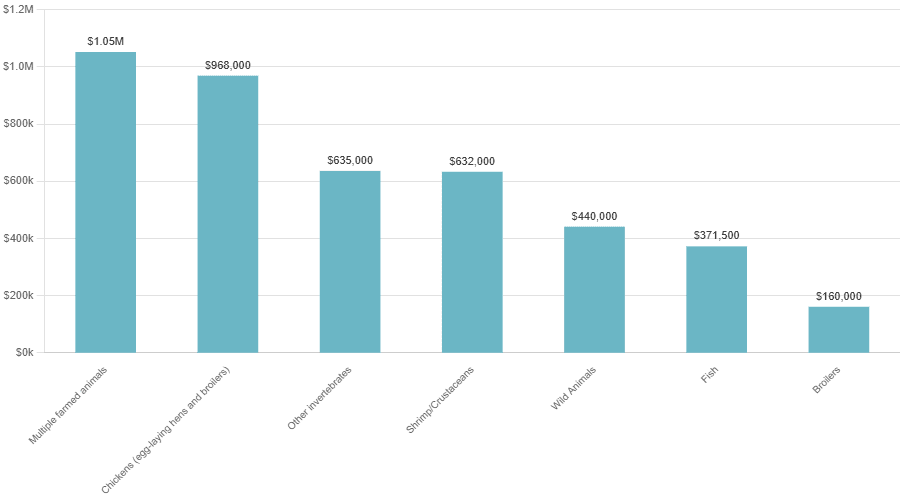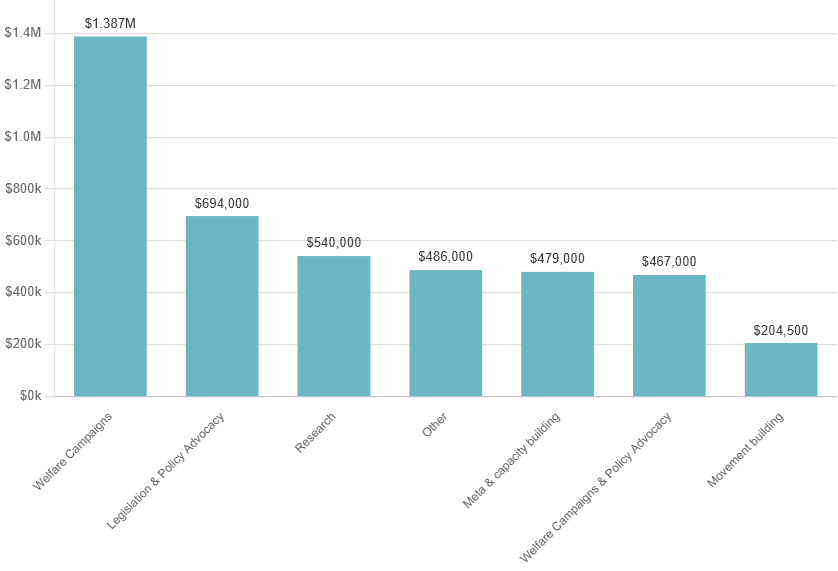440 billion farmed shrimp, 85 billion chickens, 100 billion farmed fish. These are the staggering numbers of animals raised in factory farms each year—most suffer in systems where their welfare is an afterthought, if considered at all.
But 2025 proved that strategic grantmaking can change the fate of those animals. A single $28,500 grant helped ban cages for 270,000 hens in Slovenia. $290,000 in seed funding launched campaigns that secured welfare commitments for billions of shrimp from six major European retailers in just ten months. These demonstrates how pooled resources and rigorous grantmaking can unlock and amplify the impact of many activists.
The EA Animal Welfare Fund (AWF) just published our three-year grantmaking strategy at a crucial moment for animals around the world. Having deployed $4.2M across 45 grants in 2025 (with $2M more planned for Q4), we've identified high-impact opportunities that could help the most numerous yet most neglected animals. Our strategy aims to deploy at least $20M to proven and emerging interventions, but we face an $11.6M funding gap for 2026 that will determine whether these opportunities can be leveraged or remain unexplored.
This figure may seem daunting for an individual donor. But remember that AWF operates as a pooled fund, aggregating donations that together can fund more meaningful projects than individual donations could achieve alone. In such a model, every contribution—whether $100, $1,000, $100,000, or $1M—matters. When you contribute $5,000 and another donor gives $5,000, together you can fund a pilot program that could later scale and improve welfare standards for millions of animals. This pooling effect works at every level, turning individual donations into an opportunity for major impact.
This post details AWF grantmaking in 2025, shares concrete victories from our grantees that demonstrate our approach, and shows exactly how your contribution—whether $100 or $1M—can multiply impact for the world's most overlooked animals.
Our 2025 Impact
2025 Grantmaking Overview
The EA Animal Welfare Fund focuses on high-impact, neglected opportunities. We prioritize regions where animal farming is the largest, yet animal advocacy is least established: most grants support global opportunities, with a significant focus on Global South opportunities. We support work on species like chickens in the Global South—regions where even species that receive substantial advocacy attention elsewhere get little focus—while also increasing support for species like invertebrates that are neglected globally, despite representing the vast majority of farmed animals.
In 2025, AWF has significantly expanded its grantmaking to address the most pressing challenges in farmed animal welfare. We've recommended 45 grants, totaling $4.2 million with approximately $2 million in additional grants planned for the remainder of Q4. This means we're on track to deploy over $6 million this year—a significant increase from 2024 that reflects both growing donor support and the maturation of promising opportunities.
Below is an overview of how our 2025 grants made so far are distributed across regions, species, and intervention types. You can click each image to see a full-scale version.
By region

By species

By intervention type [1]

2025 Progress From AWF’s Grantees
Our grantees achieved remarkable progress across diverse regions and species, securing tangible welfare improvements that will affect billions of animals. We've selected a few examples below that illustrate different pathways to impact—from legislative victories to corporate campaigns to research infrastructure.
Animal Enterprise Transparency Project (AETP) - Ban on Cages for Egg-laying Hens
With the EU's postponement of comprehensive animal welfare legislation, AWF recognized that country-level bans could deliver direct welfare improvements while strengthening the foundation for EU-wide reform. Slovenia presented a tractable opportunity, so AWF supported AETP with a $28,500 grant to hire essential capacity during a critical legislative period.
Since then, the progress has been remarkable. Following AETP's advocacy, in January 2025, the Ministry of Agriculture endorsed a ban on cages with the goal of phasing them out by 2028. By April 2025, the government finalized an amendment to the Animal Protection Act, including the cage ban and a ban on piglet castration without anesthesia, and submitted it to the National Assembly. On August 20, 2025, these changes were included in Slovenia’s Animal Protection Act, marking a significant victory for 270,000 hens who were still in cages and potentially hundreds of thousands of piglets.
International Council for Animal Welfare (ICAW) - Rapid Progress for Billions of Shrimp
Shrimp are the most farmed animal globally (~440 billion annually), yet receive minimal welfare protections. Corporate campaigns, which have been immensely effective for cage-free reforms, were not being utilized for these aquatic animals. Recognizing this gap, AWF provided $290,000 of seed funding to ICAW to launch the first dedicated "bad cop" campaigns targeting retailers to improve their shrimp welfare standards.
Since launching their first campaign in 2025, ICAW has achieved remarkable impact. Within just ten months, they secured six corporate commitments from major European retailers to phase out eyestalk ablation and implement pre-slaughter electric stunning. These victories include UK retailers Waitrose, Co-op, Morrisons, and Iceland; Dutch retailer Jumbo; and French retailer Les Mousquetaires—collectively affecting billions of shrimp annually. Their campaigns generated coverage in 45 media outlets, including The Guardian and the Times, and in September, ICAW expanded beyond individual country wins—launching a campaign against Aldi demanding welfare standards throughout their entire European supply chain.
Animal Welfare League (AWL) - Establishing National Poultry Standards in Ghana and Increasing Supply of Cage-Free Across Africa
Africa is poised to become the world's fastest-growing egg production region; according to FAO projections, it will surpass Asia and Latin America by 2030. Yet hundreds of millions of layer hens remain confined to battery cages with minimal welfare oversight. Africa has received only 1.2% to 2.6% of global animal advocacy funding despite its massive scale. AWF has supported AWL since 2022 through four grants totaling over $300,000. Our latest grant of $130,000 in January 2025 enables AWL to scale impact through policy intervention in Ghana and regional work in South Africa and Morocco.
Since then, AWL secured a Memorandum of Understanding with Ghana's Standards Authority to co-develop national poultry standards that could affect all of Ghana’s 23 million hens—potentially making it one of the first African nations with a cage-free code of practice. Simultaneously, AWL worked at the corporate and producer levels, creating cage-free directories and signing up nine commercial producers across South Africa and Morocco, impacting 35,000 hens, while introducing farmers to Certified Humane certification. By establishing regulatory frameworks and market connections before intensive cage systems become entrenched, AWL could prevent suffering for millions of future hens during Africa's critical agricultural expansion period.
While these victories demonstrate the impact of completed work, immense opportunities remain to expand our impact for animals; our strategic goals show how we're building the pipeline for future progress.
How Your Support Turns Into Impact for Animals
Objectives: Six Strategic Goals Your Funding Enables
Our approach focuses on filling critical gaps in the animal advocacy ecosystem. Our strategy prioritizes large, neglected species of animals, as well as farmed animals in the Global South, where the majority of suffering occurs but disproportionately little attention is paid. We plan to maintain our role as an early-stage funder, supporting novel interventions, while also stepping in to provide scale-up support when proven work faces funding gaps that other grantmakers can't or won't fill. This strategy ensures AWF remains focused on delivering maximum counterfactual impact for animals worldwide.
By supporting AWF, you join our collective effort to deploy $20M+ strategically. Every gift, from $100 to $1M, contributes to a community of donors pooling resources to pursue concrete long-term objectives that could change the fate of the most numerous animals and reshape animal agriculture globally. For each goal below, we've identified specific approaches and opportunities that would accelerate progress.
Ending Cage Confinement for Hens Globally, Accelerating Progress in the Global South
While wealthy nations are starting to phase out battery cages, hundreds of millions of hens remain confined across Asia, Africa, and Latin America. Your funding could support:
- Targeted corporate campaigns in countries where formal markets are growing—transitioning current cage systems to cage-free and securing commitments before cage systems become entrenched
- Producer training programs creating cage-free supply in regions where companies want to transition but lack sourcing options
- Accountability campaigns ensuring nearly 200 Asian companies with 2025 cage-free deadlines follow through
- Work with policymakers in African countries developing their first poultry standards, with the goal of establishing cage-free as the baseline rather than fighting to reform entrenched systems decades later
Establishing Aquatic Animal Welfare Standards in the Global South
To improve the welfare of farmed shrimp and fish, your funding could support:
- R&D to develop and test practical on-farm welfare improvements such as sludge removal, water quality improvements, stocking density reduction and more
- Targeted welfare pilot programs with high-potential producers, scaling those that prove to be sufficiently cost-effective
- Policy advocacy to improve national shrimp and fish welfare standards
Making Humane Slaughter the Default for Farmed Shrimp
We've seen proof that retailers will commit to stunning requirements and eyestalk ablation bans—now we need to make implementation universal, ending one of the cruelest deaths in animal agriculture for 440 billion animals annually. Your funding could support:
- Initiatives to supply electrical stunning equipment directly to producers in Asia and Latin America, removing the cost barrier to adoption
- Expansion of corporate and producer campaigns to other European countries and to the US market in order to implement stunning and eyestalk ablation bands and reshape global supply chains
- Engagement with certification bodies to integrate stunning into standard requirements
Preventing the Next Factory Farming Crisis Through Strategic Invertebrate Welfare Work
Research and Implementing Proven Interventions to Reduce Wild Animal Suffering
We plan to support work that researches and pilots interventions reducing wild animal suffering, especially those that could be implemented in the near future and reach a high level of cost-effectiveness. Among others, we plan to explore:
- Humane rodent fertility control programs to replace inhumane rodenticide poisoning that causes extreme suffering before death
- Replacing culling with contraceptives
- Ways to transition to faster-acting insecticides in agricultural settings
- Efforts to build legitimacy and support around WAW issues among key stakeholder groups
Transforming Farm Animal Welfare Across Asia, Africa, and Latin America
Beyond species-specific work, we would strengthen the foundation for advocacy across the Global South. We'd help isolated advocates share strategies and resources, multiplying impact across borders. Your funding could support::
- Core operational funding to proven organizations that lack stable support
- Funding to scale successful interventions
- Movement coordination and capacity building
Each objective represents millions or billions of animals whose suffering could be prevented or reduced. With proven models ready to scale and narrow windows of opportunity, your support transforms these strategic goals into concrete victories for animals.
Funding Gap: What Different Contribution Levels Enable
Our 2026 strategy aims to deploy at least $20M+ annually to maximize counterfactual impact for the world's most neglected animals. We currently have about $8.4M in committed funding, leaving an $11.6M gap to make this strategy a reality.
As described above, AWF pools donations of all sizes to fund transformative work. The examples below show how contributions at different levels—from $100 to $1M—come together to create the grants that achieve these outcomes. These are illustrative examples, but are inspired by real grants AWF have made in the past, thanks to contributions from donors at different levels of giving.
$10,000 – Provide a stipend to scope out policy opportunities in a key region
This could lay the groundwork for legal protections in high-priority countries where animal welfare legislation is non-existent or developing, such as:
- Establishing cage-free welfare legislation in African countries developing their first poultry standards
- Securing fish welfare provisions in new aquaculture legislation in some of the largest global producer countries
- Implementing welfare practices in insect production in Asia
$30,000 – Fund a pilot implementation program to test welfare interventions
Examples include:
- Working directly with fish producers in Africa to implement humane stunning systems
- Testing water quality improvements and sludge removal with shrimp farmers in Asia
- Piloting fertility control as an alternative to rodenticide poisoning in urban settings
$50,000 – Fund a dedicated campaigner running corporate campaigns, policy advocacy, or producer engagement
Examples include:
- Cage-free campaigners securing corporate commitments in Thailand or Malaysia where formal markets are growing
- Producer engagement to transition fish farmers to higher welfare practices in Ghana or Kenya
- Investor engagement to reduce capital flow into farming of numerous and neglected species in East Africa or Southeast Asia
- National policy advocacy to pass poultry welfare standards in Africa
$100,000 – Support research and field-building for emerging welfare interventions
Examples include:
- Research identifying and testing cost-effective wild animal welfare interventions ready for deployment
- Large-scale R&D into on-farm shrimp welfare improvements
- Field building for numerous and neglected species
$130,000 – Scale cage-free advocacy across multiple countries in a priority region
Examples include:
- "Bad cop" accountability campaigns across Latin America ensuring companies meet their commitments
- Scaling cage-free work from one successful country to three neighboring markets in Southeast Asia
- Combined corporate and producer outreach establishing cage-free supply chains in multiple African countries
$300,000 – Support the creation of a new organization launching campaigns for neglected species
Examples include:
- Start a new organization, securing corporate commitments for shrimp
- Seed a new group working on securing humane slaughter commitments for fish
- Launch an organization aiming to develop new welfare standards for numerous and neglected species and propagate them in the industry
Please join us in the mission to alleviate animal suffering on a massive scale
With each month that passes, more battery cages get built, intensive systems become entrenched, and preventable suffering continues at a massive scale. With our 3-year strategy and a pipeline of high-impact opportunities, AWF is positioned to deploy resources where they'll create the most counterfactual value and stop these harmful trajectories. These opportunities—whether establishing welfare standards before industries scale, supporting accountability campaigns as corporate deadlines approach, or building advocacy capacity in underserved regions—represent some of the highest expected-value giving opportunities in animal welfare.
On a personal note, this work has always been very motivating for me. I’ve seen how individuals taking action can change the fate of millions of sentient animals—how, in light of such a vast problem, each and every person working to counter animal suffering matters. So I want to invite you to join us in those efforts!
Take action now:
DONATE TO AWF- If you are considering a gift that feels significant and want more information, please contact me at karolina@effectivealtruismfunds.org
- Share this opportunity with others who care about impactful animal advocacy and invite them to support this mission
Thank you!
- ^
Note on categorization:
"Welfare Campaigns" include all activities aimed at reducing farm animal suffering or increasing welfare, such as corporate outreach, producer outreach, accountability work on prior commitments, work with certifiers, etc.
"Policy Advocacy" is a broad term that includes policy work, legislative advocacy, and litigation.
The category "Welfare Campaigns and Policy Advocacy" contains grants where organizations engage in significant portions of both activities.
"Meta and Capacity Building" focuses on improving the effectiveness and resourcing of the animal advocacy movement, including evaluations of interventions, fundraising for effective organizations, strategic convenings, and implementation support.
"Movement Building" focuses on strengthening the advocacy community through activities like training programs and conferences for advocates in a specific region.
"Other" includes activities not well-suited to the other categories, such as general support for organizations that engage in many activities, investor engagement to decrease funding for animal farming industries, content creation, etc.

Thanks for writing this insightful piece.
Is there any reason why you only mentioned the 1-1.2T insects raised for food and feed and didn't mention farmed honeybees or cochineals? At any given time there are more than a trillion managed honey bees, and the farming of cochineal directly causes 4.6T to 21T additional deaths, primarily of male and female cochineal nymphs, and adult male cochineals.